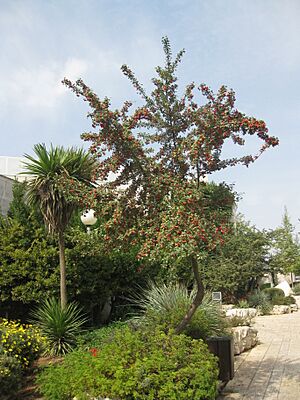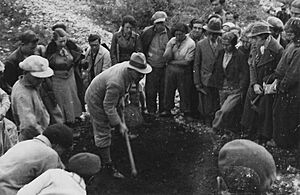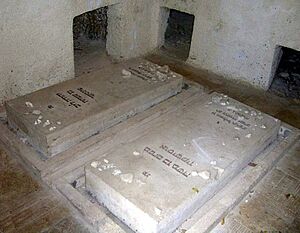National Botanic Garden of Israel facts for kids
Quick facts for kids National Botanic Garden of Israel |
|
|---|---|
 |
|
| Location | Mount Scopus, Jerusalem |
| Created | 1931 |
| Operated by | Hebrew University of Jerusalem |
| Status | Open all year |
The National Botanic Garden of Israel is a special place for plants located on Mount Scopus in Jerusalem. It's also known by its official name, the Montague Lamport Botanical Garden for the Native Plants of Israel. This garden is part of the Hebrew University of Jerusalem.
It has a huge collection of dried plant samples, called a herbarium, which is identified by the code HUJ. The garden covers an area of about 25 dunams, which is like 25 small fields. Inside, you can find 950 different kinds of plants! About 40% of these plants grow wild in nature.
Discovering the Garden
This garden was the very first botanical garden ever created in the Land of Israel. Its main job is to keep a record of all the wild plants found in Israel and the wider Middle East.
The garden is located on the northern side of the Hebrew University campus on Mount Scopus in Jerusalem. All around the garden, you can find ancient burial caves that are from the time of the Second Temple period. On the western side of the garden, there's a small outdoor theater, like a mini-amphitheater.
The garden is also a special nature reserve and a National park. This means it helps protect nature. It has a Natural Teaching Center where you can learn about plants. It also holds the biggest library of plant books in Israel and a weather station. There's a walking path on the western side named after an Israeli writer, Avigdor Hameiri. Near the main entrance, a stone tablet has his famous poem "On the summit of Mount Scopus."
A Look Back at the Garden's History
The National Botanic Garden was started in 1931. It was founded by Otto Warburg, who also started the university's Botany Department, along with another botanist named Alexander Eig. This was the first botanical garden in the Land of Israel.
Alexander Eig was a very important part of the garden's early days. He taught at the university and worked hard on the garden until he passed away. He was the one who planted the very first tree in the garden! He also created a plan to protect the local plants. He traveled to places like Syria, Turkey, Iraq, and Lebanon to collect plants. He even brought back seedlings from 350 different Cedrus trees.
For a short time, from 1947 to 1950, this garden was also the first home of the Jerusalem Biblical Zoo. During a difficult time in 1948, when there wasn't much food in Jerusalem, the zookeepers had to find creative ways to feed the animals. Many animals sadly didn't survive, and some non-dangerous ones had to be set free. In 1950, with help from the United Nations, the remaining animals were safely moved to a new location in the city.
The garden was not taken care of for 19 years because the Mount Scopus campus became a small area controlled by Israel, surrounded by Jordan. Because of this, a new botanical garden, the Jerusalem Botanical Gardens, opened in western Jerusalem in 1954.
In 1980, people started working to fix up the old garden on Mount Scopus. It finally reopened in 1988. This garden is special because it was the first in the world to be called an "ecological garden." This means it's designed to help protect nature. Many of the plants you see here are very rare or don't even exist in the wild anymore.
Ancient Burial Caves
Inside the garden, you can find the Cave of Nicanor. This is an ancient burial cave that was discovered in 1902. It dates back to the Second Temple period. An old writing inside the cave shows it was the grave of "Nicanor," who built the doors for the First Temple in Jerusalem.
Later, in 1934, the remains of Leon Pinsker were reburied in this cave. This was done because Menachem Ussishkin wanted to create a special burial place for national leaders on Mount Scopus. However, Ussishkin himself, who passed away in 1941, was the only other person buried there. After Israel became a state in 1948, a new national leaders' burial site was created on Mount Herzl. This happened partly because Mount Scopus became an isolated area surrounded by Jordanian territory.
See also
 In Spanish: Jardín Botánico Nacional de Israel para niños
In Spanish: Jardín Botánico Nacional de Israel para niños
- List of botanical gardens in Israel
- List of endemic flora of Israel
- Wildlife of Israel




